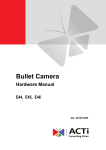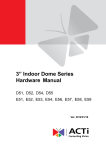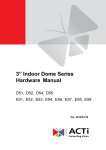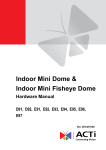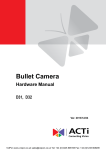Download ACTi E23 surveillance camera
Transcript
Box Camera Series Hardware Manual D21 (D21F / D21V) D22 (D22F / D22V) E21 (E21F / E21V) E22 (E22F / E22V) E23, E24, E25 2013/12/04 Hardware Manual Table of Contents Precautions ............................................................. 3 Safety Instructions .................................................................................... 5 Introduction ............................................................. 6 The List of Models ..................................................................................... 6 Package Contents...................................................................................... 8 Physical Description ................................................................................. 9 Installation and Access ........................................ 10 Camera Installation.................................................................................. 10 Accessing Camera................................................................................... 12 2 Hardware Manual Precautions Read these instructions You should read all the safety and operating instructions before using this product. Heed all warnings You must adhere to all the warnings on the product and in the instruction manual. Failure to follow the safety instruction given may directly endanger people, cause damage to the system or to other equipment. Servicing Do not attempt to service this video device yourself as opening or removing covers may expose you to dangerous voltage or other hazards. Refer all servicing to qualified service personnel. Trademarks All names used in this manual are probably registered trademarks of respective companies. Liability Every reasonable care has been taken during the writing of this manual. Please inform your local office if you find any inaccuracies or omissions. We cannot be held responsible for any typographical or technical errors and reserve the right to make changes to the product and manuals without prior notice. 3 Hardware Manual Federal Communications Commission Statement This equipment has been tested and found to comply with the limits for a class B digital device, pursuant to Part 15 of the FCC Rules. These limits are designed to provide reasonable protection against harmful interference in a residential installation. This equipment generates, uses, and can radiate radio frequency energy and, if not installed and used in accordance with the instructions, may cause harmful interference to radio communications. However, there is no guarantee that interference will not occur in a particular installation. If this equipment does cause harmful interference to radio or television reception, which can be determined by turning the equipment off and on, the user is encouraged to try to correct the interference by one or more of the following measures: Reorient or relocate the receiving antenna. Increase the separation between the equipment and receiver. Connect the equipment into an outlet on a circuit different from that to which the receiver is connected. Consult the dealer or an experienced radio/TV technician for help. Warning: Changes or modifications to the equipment that are not expressly approved by the responsible party for compliance could void the user’s authority to operate the equipment. European Community Compliance Statement This product has been tested and found to comply with the limits for Class B Information Technology Equipment according to European Standard EN 55022 and EN 55024. In a domestic environment, this product may cause radio interference in which cause the user may be required to take adequate measures. 4 Hardware Manual Safety Instructions Cleaning Disconnect this video product from the power supply before cleaning. Attachments Do not use attachments not recommended by the video product manufacturer as they may cause hazards. Do not use accessories not recommended by the manufacturer Only install this device in a dry place protected from weather Servicing Do not attempt to service this video product yourself. Refer all servicing to qualified service personnel. Damage Requiring service Disconnect this video product from the power supply immediately and refer servicing to qualified service personnel under the following conditions. 1) When the power-supply cord or plug is damaged 2) If liquid has been spilled, or objects have fallen into the video product. 3) If the inner parts of video product have been directly exposed to rain or water. 4) If the video product does not operate normally by following the operating Instructions in this manual. Adjust only those controls that are covered by the instruction manual, as an improper adjustment of other controls may result in damage, and will often require extensive work by a qualified technician to restore the video product to its normal operation. Safety Check Upon completion of any service or repairs to this video product, ask the service technician to perform safety checks to determine if the video product is in proper operating condition. 5 Hardware Manual Introduction The List of Models This hardware manual contains the following models: D21F (D21) 1MP Box with D/N, Fixed lens D21V (D21) 1MP Box with D/N, Vari-focal lens D22F (D22) 5MP Box with D/N, Fixed lens D22V (D22) 5MP Box with D/N, Vari-focal lens E21F (E21) 1MP Box with D/N, Basic WDR, Fixed lens E21V (E21) 1MP Box with D/N, Basic WDR, Vari-focal lens E22F (E22) 5MP Box with D/N, Basic WDR, Fixed lens E22V (E22) 5MP Box with D/N, Basic WDR, Vari-focal lens E23 2MP Box with D/N, Basic WDR, SLLS, Vari-focal lens E24 3MP Box with D/N, Superior WDR, Vari-focal lens 6 Hardware Manual E25 1.3MP Box with D/N, Basic WDR, SLLS, Vari-focal lens From the installation perspective these models are very similar; therefore you can use one manual for all of them. 7 Hardware Manual Package Contents 1. Camera 2. Lens OR Fixed focal lens with manual focus and fixed iris 3. Mounting Block Vari-focal lens with manual focus and DC iris 4. Quick Installation Guide Mounting block for mounting the camera to a bracket. 8 Hardware Manual Physical Description 1) Ethernet Port The IP device connects to the Ethernet via a standard RJ45 connector. 2) Reset Button The purpose of reset button is to restore the factory default settings of the camera, including administrator’s password. The reset button can be used for following purposes: 1. The administrator’s password has been forgotten and therefore the camera cannot be accessed. 2. In case of IP address, mask, or allow/deny filter related issues, resulting with inability to modify these settings. 3. In case of connectivity issues or abnormal video quality. How to do the reset properly? Step 1: Disconnect the power supply (e.g. disconnect the Ethernet cable with PoE). Step 2: Press and continue to hold the Reset Button (using a pin). Step 3: Connect the power supply while keeping the Reset Button pressed. Step 4: Wait for 45 seconds and release the Reset Button. 3) Power LED When the Power LED is on, the camera is successfully powered on by PoE and the system is running. It is possible to disable Power LED by URL command if necessary. 4) DC Iris Port When the DC iris lens is used, the cable of the lens has to be connected to this port. 9 Hardware Manual Installation and Access Camera Installation The box camera may be installed indoors or outdoors (requires waterproof housing). In both cases, the mounting block (included in the package) is needed. Indoor Installation For ceiling installations, the mounting block has to be mounted to the top side of the camera. For wall installations, the mounting block has to be mounted to the bottom side of the camera. An additional mounting bracket is needed to complete the installation (not included in the package). You may use any of the local suppliers or purchase one from the camera manufacturer. The following bracket is offered by the camera manufacturer: This camera can be surface mounted without needing any additional accessories. Use the screws from the screw pack and mount the camera to the surface using following screw holes. Outdoor Installation Outdoor installations require waterproof housing and the heavy duty bracket. The following housing solutions are offered by the manufacturer: The outdoor bracket can be mounted onto the wall. 10 Hardware Manual For pole or corner installations, you may consider following solutions: The housing can be either PMAX-0200, 0201 or PMAX-0202. 11 Hardware Manual Accessing Camera Connect the Equipment To be able to connect to the camera firmware from your PC, both the camera and the PC have to be connected to each other via Ethernet cable. At the same time, the camera has to have its own power supply. In case of PoE cameras, you can use a PoE Injector or a PoE Switch between the camera and the PC. The cameras that have the DC power connectors may be powered on by using a power adaptor. The Ethernet port LED or Power LED of the camera will indicate that the power supply for the camera works normally. Configure the IP Addresses In order to be able to communicate with the camera from your PC, both the camera and the PC have to be within the same network segment. In most cases, it means that they both should have very similar IP addresses, where only the last number of the IP address is different from each other. There are 2 different approaches to IP Address management in Local Area Networks – by DHCP Server or Manually. Using DHCP server to assign IP addresses: If you have connected the computer and the camera into the network that has a DHCP server running, then you do not need to configure the IP addresses at all – both the camera and the PC would request a unique IP address from DHCP server automatically. In such case, the camera will immediately be ready for the access from the PC. The user, however, might not know the IP address of the camera yet. It is necessary to know the IP address of the camera in other to be able to access it by using a Web browser. The quickest way to discover the cameras in the network is to use the simplest network search, built in the Windows system – just by pressing the “Network” icon, all the cameras of the local area network will be discovered by Windows thanks to the UPnP function support of our cameras. 12 Hardware Manual In the example below, we successfully the camera model that we had just connected to the network. By clicking with the mouse click on the camera model, it is possible to automatically launch the default browser of the PC with the IP address of the target camera filled in the address bar of the browser already. If you work with our cameras regularly, then there is even a better way to discover the cameras in the network – by using IP Utility. The IP Utility is a light software tool that can not only discover the cameras, but also list lots of valuable information, such as IP and MAC addresses, serial numbers, firmware versions, etc, and allows quick configuration of multiple devices at the same time. The IP Utility can be downloaded for free from our website. 13 Hardware Manual With just one click, you can launch the IP Utility and there will be an instant report as follows: You can quickly notice the camera model in the list. Click on the IP address to automatically launch the default browser of the PC with the IP address of the target camera filled in the address bar of the browser already. Use the default IP address of a camera: If there is no DHCP server in the given network, the user may have to assign the IP addresses to both PC and camera manually to make sure they are in the same network segment. When the camera is plugged into network and it does not detect any DHCP services, it will automatically assign itself a default IP: 192.168.0.100 Whereas the default port number would be 80. In order to access that camera, the IP address of the PC has to be configured to match the network segment of the camera. 14 Hardware Manual Manually adjust the IP address of the PC: In the following example, based on Windows 7, we will configure the IP address to 192.168.0.99 and set Subnet Mask to 255.255.255.0 by using the steps below: 1 3 2 4 15 Hardware Manual Manually adjust the IP addresses of multiple cameras: If there are more than 1 camera to be used in the same local area network and there is no DHCP server to assign unique IP addresses to each of them, all of the cameras would then have the initial IP address of 192.168.0.100, which is not a proper situation for network devices – all the IP addresses have to be different from each other. The easiest way to assign cameras the IP addresses is by using IP Utility: With the procedure shown above, all the cameras will have unique IP addresses, starting from 192.168.0.101. In case there are 20 cameras selected, the last one of the cameras would have the IP 192.168.0.120. Later, by pressing the “Refresh” button of the IP Utility, you will be able to see the list of cameras with their new IP addresses. Please note that it is also possible to change the IP addresses manually by using the Web browser. In such case, please plug in only one camera at a time, and change its IP address by using the Web browser before plugging in the next one. This way, the Web browser will not be confused about two devices having the same IP address at the same time. 16 Hardware Manual Access the Camera Now that the camera and the PC are both having their unique IP addresses and are under the same network segment, it is possible to use the Web browser of the PC to access the camera. You can use any of the browsers to access the camera, however, the full functionality is provided only for Microsoft Internet Explorer. The browser functionality comparison: Functionality Internet Explorer Other browsers Live Video Yes Yes* Live Video Area Resizable Yes No PTZ Control Yes Yes Capture the snapshot Yes Yes Yes No Yes Yes Video overlay based configuration (Motion Detection regions, Privacy Mask regions) All the other configurations * When using non-Internet Explorer browsers, free third-party software plug-ins must be installed to the PC first to be able to get the live video feed from the camera. Check the firmware version of the camera to determine which plug-in is necessary: Firwmware Version Required Plug-In A1D-500-V6.04.xx-xx or older Basic VLC Media Player (http://www.videolan.org) A1D-500-V6.05.xx-xx or newer QuickTime (http://www.apple.com/quicktime/download/) The camera firmware version can be found on the FW Version column of the IP utility or access the Setup page of the Web Configurator (see page 19). Disclaimer Notice: The camera manufacturer does not guarantee the compatibility of its cameras with VLC player or QuickTime – since these are third party softwares. The third party has the right to modify their utility any time which might affect the compatibility. In such cases, please use Internet Explorer browser instead. When using Internet Explorer browser, the ActiveX control for video stream management will be downloaded from the camera directly – the user just has to accept the use of such control when prompted so. No other third party utilities are required to be installed in such case. 17 Hardware Manual The following examples in this manual are based on Internet Explorer browser in order to cover all functions of the camera. Assuming that the camera’s IP address is 192.168.0.100, you can access it by opening the Web browser and typing the following address into Web browser’s address bar: http://192.168.0.100 Upon successful connection to the camera, the user interface called Web Configurator would appear together with the login page. The HTTP port number was not added behind the IP address since the default HTTP port of the camera is 80, which can be omitted from the address for convenience. Before logging in, you need to know the factory default Account and Password of the camera. Account: Admin Password: 123456 18 Hardware Manual To check the firmware version through the Web Configurator, access the Setup page and click System > System Info. 1 2 3 For further operations, please refer to the Firmware User Manual. 19





















